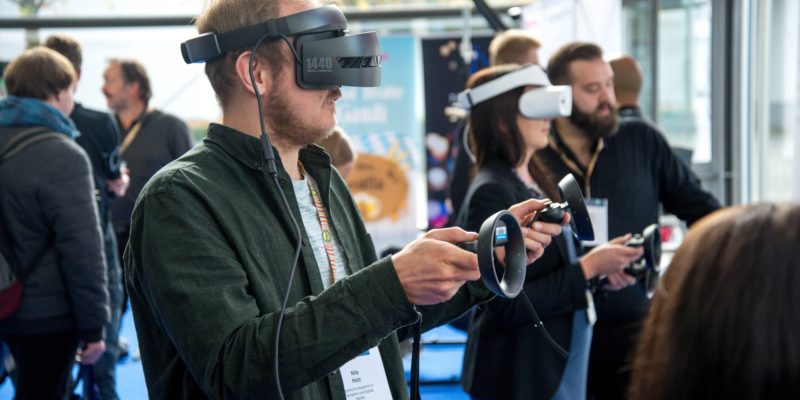Currently, VR is a tool used in aviation and sports, as a training aid, and as a communications tool. There are many uses for VR, but some applications go beyond these. Let’s look at a few of them. First, let’s discuss its use as a training aid.
VR as a training aid
Virtual reality (VR) can help business leaders upskill their employees more quickly and efficiently. As training budgets shrink and in-person training is often off-limits, companies must ensure they make the most efficient use of limited time and resources. Virtual reality offers a cost-effective solution to this problem. The technology is now readily available on consumer-grade virtual reality devices, making it a more affordable option than ever.
Another advantage to VR as a training aid is that it requires no real materials. It helps cut down on expenses associated with the production of real products. Furthermore, users only handle the simulated resources, leaving the real ones free for production. In addition to reducing training costs and saving on materials, VR simulations provide new workers with hands-on training without the risk of causing any harm to other workers.
VR simulations can also help managers practice difficult workplace conversations. The software enables employees to view animated electrical components and identify flaws in production systems. VR training has also helped companies such as T-Mobile prepare for the merger with Sprint. The company has since expanded its VR training to include support for traumatised employees.
It’s a communication tool
Virtual reality can be used for a variety of purposes, including communication. It can be a valuable communication tool for businesses and organisations. BIM environments can be challenging to navigate and distract designers from the design process. VR can help mitigate these problems. The design process can help a business present a realistic view of the project.
As VR technology improves, it will become more affordable and accessible. Creating a complete VR experience using a mobile phone will soon be possible. As pixels and wires become almost imperceptible, people will grow accustomed to wearing VR goggles. As VR becomes more widely available, communication will become more about design rather than content.
The potential for VR as a communication tool has been suggested since the 1990s. However, it should be noted that this technology has several technological challenges that need to be overcome. Research and analysis are essential to help understand how VR can impact communication. VR can be a valuable tool if it can facilitate face-to-face communication.
It’s a training aid in sports
Virtual reality (VR) is an immersive virtual environment simulating various sports’ movements. Its features include manipulating objects, viewing different perspectives, and altering movement trajectories. VR is used for various sports, including running, rowing, and ball. It also provides guidance and informative feedback.
The effectiveness of VR is not well studied, but clinical research shows that it can have significant benefits in sports performance analysis. It has not been widely used in specialised sports training but has been successfully used in rehabilitation and clinical trials. In sports, it is beneficial for open-skill disciplines where athletes must constantly adapt to changing opponents’ behaviour. Therefore, combat sports and team sports coaches should consider incorporating VR into their training regime.
Virtual reality technology is still in its infancy, so it may need frequent updates or replacement of old hardware. It can be time-consuming, especially if you don’t have a full-time IT department. It may also have unintended side effects, including headaches, eye problems, and nausea. These side effects typically occur from overuse, so athletes need to set up a proper training schedule and learn how to use VR technology.
It’s a training aid in aviation
Virtual reality is an excellent way for future aviation engineers to learn their craft. Unlike traditional classroom training, where an engineer must learn the details of a specific aircraft and spend hours in front of a textbook, VR can allow an engineer to learn about various aircraft and study any detail. Companies such as Pratt & Whitney are already using VR to train mechanics.
While VR is already used in the defence sector for pilot training, it is becoming increasingly helpful in training the cabin crew. Lufthansa, Europe’s largest airline by passenger volume, recently announced that it would start VR training for flight attendants. The company hopes to establish VR training as the new standard for aviation staff training. It intends to install 18 VR training cabins and train 18,500 flight attendants annually.
VR technology is rapidly advancing and has the potential to become a major game-changer. In addition to training pilots, immersive technology is being used in other industries to streamline operations, improve capabilities, and improve service. It is essential in aviation, where mistakes can be extremely costly.
It’s an entertainment tool
Virtual reality, also known as VR, is a new way to experience digital content completely immersively. This technology is becoming increasingly popular among consumers and has many potential uses in the entertainment and other industries. It provides an immersive way to experience digital content on desktop and mobile devices. Virtual reality technology from https://3dwalkabout.com.au/virtual-reality-brisbane/ is a game changer that can help people enjoy movies and games in a new way.






Comments